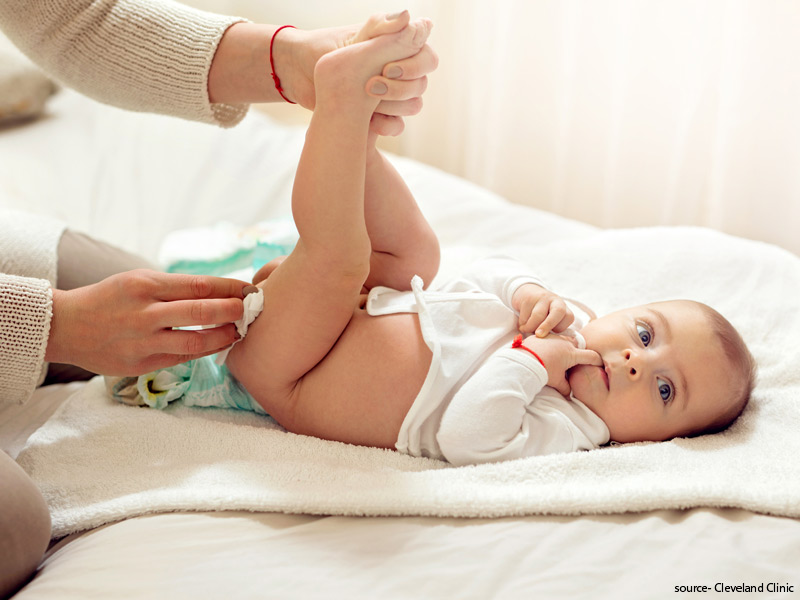
Diaper rash is one of the most common skin problems faced by infants and toddlers. While it can occur during any time of the year, it most commonly occurs in the Monsoon season. The damp weather and increased occurrence of various infections like diarrhoea create a conducive environment for its occurrence. The rash being in a weight bearing area (perineum) can be very painful and distressing for the baby and also for parents and caregivers. While being largely mild to moderate, sometimes it can be very severe, especially if unattended or if the underlying cause is not treated. So, parents, before your baby gets extremely irritated and troubled due to diaper rash in the humid weather, take preventive measures to cut down the risk of diaper dermatitis.
What Causes Diaper Rash?
First-time parents do not really know about diaper dermatitis. Here is a brief explanation by Dr Chetan Mundada, Senior Consultant Paediatrician at Yashoda Hospitals, Secunderabad- Diaper Rash usually occurs as a manifestation of reaction of skin to irritants like moisture, stools, urine and friction.
- Wet damp skin becomes more permeable to water leading to swelling and breach of natural defences of the outer layer of skin leading to rash.
- Diarrhea, increased sweating due to hot or humid weather and fever, urinary infections, and atopic dermatitis commonly lead to Diaper rash.

Types of Diaper Rash
- When it is due to irritant dermatitis, it is present in the protruding areas of the perineum which are in maximum contact with the diapers, sparing the groin folds. It is mild red, shiny with/without papules.
- The candidal rash involves the skin folds and spares the convex surfaces. It is wet/weepy, bright red with denuded skin with papules in peripheries and satellite papules. A diaper rash present for more than 72 hours will usually have candida (Fungus) infection
Also Read: Is It Safe To Make Babies Wear Diapers Daily? Know What A Pediatrician Has To Say
How To Prevent Diaper Rash?
Prevention should be the main aim of Diaper rash management. Prevent damage of the outermost skin layer by:
- Keeping the skin dry– Frequent change of diapers (single most important step). Change soiled diapers asap and when a rash is already present, change diapers every 2-3 hours. Washing cloth diapers in hot water with mild detergent and bleach and adding fabric softener keeps the cloth soft and avoids friction. Superabsorbent disposable diapers soak moisture and reduce the severity of rash.
- Letting the child stay without diaper for some time with rash area exposed to air (In prone position)
- Using mild soaps which maintain the skin pH between 4.5 to 5 and water to clean after stooling. Water alone or non-soap cleanser baby wipes are useful for routine care
- Using protective creams, ointments, emollients, coconut oil
Also Read: Tips For First-Time Parents To Keep The Baby Safe In Rainy Season
Treatment

The treatment depends on the severity of the rash. A mild irritant rash usually gets under control by simple protective creams containing zinc, along with the aforementioned preventive measures. Avoid overzealous cleaning/ rubbing of the inflamed skin.
More severe rash needs a review by a Doctor who may use topical antifungals with thicker ointments & pastes and sometimes topical low potency steroids and antibiotics. One also needs to look for candidal infection elsewhere like mouth, face and hands and treat them.
Recurrent severe candida rashes in a baby should prompt an investigation to assess for any immunodeficiency. Treating underlying cause like diarrhea promptly halts progression of the rash.
Diaper rash is highly common in monsoon season due to wet and humid weather. Besides, skin infections are also prevalent and therefore, parents must take advance measures to keep their baby safe from rashes and infections. Exercise the tips suggested by paediatrician in this article to prevent diaper dermatitis in you child.
Read More Articles in Newborn Care
Also watch this video
How we keep this article up to date:
We work with experts and keep a close eye on the latest in health and wellness. Whenever there is a new research or helpful information, we update our articles with accurate and useful advice.
Current Version